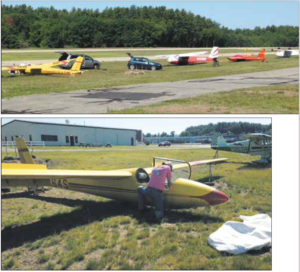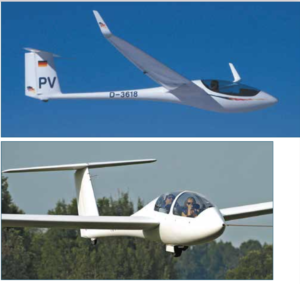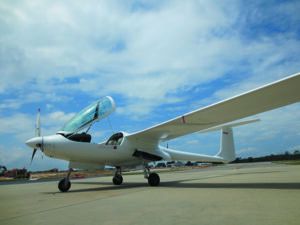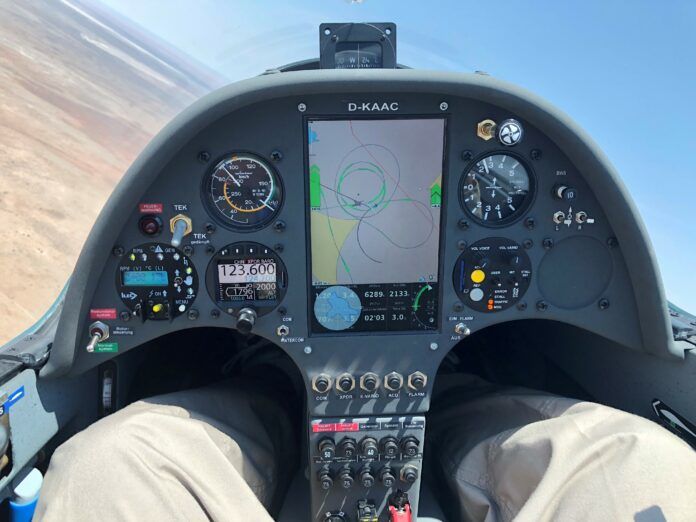You took advantage of some free time to go flying over the weekend. It had been almost two months since your last flight, so you took the rental 172 around the pattern nearly a dozen times and got the rust off of your crosswind landings. On the drive home you replayed the flight in your mind and suddenly realized that your next thought was, “Now what?” You’re getting bored. Grinding around the pattern isn’t as fun as it once was—which is why you haven’t been flying as much as in past years. There’s got to be a new challenge to meet.
You run through a mental checklist: Tailwheel checkout—accomplished, but the trainer was groundlooped and never rebuilt; there’s nothing aerobatic to rent in the area; you want to get a multi-engine rating but the cost and inability to afford to rent a twin—even if one is available—after the rating makes that unrealistic.
However, there’s a glider operation not too far away. Hey—that sounds like fun. What’s involved in adding on a glider rating?
GLIDER TRANSITION
In talking with dozens of airplane pilots who have earned glider pilot certificates, every single one has described how much he or she enjoyed what many described as the more pure flying experience of gliders. My personal experience was that learning to fly gliders was a lot of fun, having to go through a checkride was no big deal and I enjoyed what was a much more social experience than is involved with airplanes—it takes a group of people to launch a glider.
If you hold at least a private pilot ASEL certificate, Part 61.109(f) of the FARs requires that you must log at least three hours in a glider learning and demonstrating glider-specific operations, including 10 solo flights and three training flights with an instructor in preparation for the practical test (checkride).
That’s it. Plus, as the holder of a private pilot airplane certificate you do not have to take a written exam to add on a glider rating. What’s not to like?
And … you don’t need a medical. Is that great or what?
I’ll stick in an aside here—if you hold at least a commercial airplane pilot certificate a commercial glider add-on is not that much more involved than the private. It requires that you have 200 hours of flight time in heavier-than-air aircraft and at least 20 flights in a glider as pilot in command, including three hours of flight training on 10 training flights on required areas of operation, five solo flights performing required areas of operation and three training flights in preparation for the practical test.
From personal experience, in my opinion, it’s worth going straight for the commercial.
TRAINING
There are some commercial glider operations in the country—and most are in areas of the country with weather that allows flying throughout the year (gliders don’t have heaters). My research for this article indicated that glider clubs are more common and it’s likely that the closest place for you to learn to fly sailplanes will be a club.
Getting your rating through a glider club will probably be cheaper than at a commercial operation; however, scheduling flights with a club may or may not be easy. Many clubs only fly on weekends and at most of the clubs we spoke with it’s necessary to show up and get in line as we’ll as pitch in to help move aircraft on the ground and assist with launches.
Commercial operators are more likely to have a computerized scheduling system and fly during the week so that you can spend less time and fly more often than with a club. The tradeoff is that we think that it’s not unreasonable to get a private glider add-on through a club for under $2,000 while it may be about twice that at a commercial operator—although the type of glider used affects the cost. Higher-performance fiberglass ships cost more and being more “slippery” than the tube and fabric trainers usually take longer to solo.
GETTING STARTED

When the urge to soar manifests itself, spend some time on the website of the Soaring Society of America (SSA) (www.ssa.org). The current site contains a wealth of information on gliders, learning to fly them, locations of clubs and schools, resource materials, safety, racing and post-rating achievement. According to SSA President Denise Layton, the website is being upgraded with access to even more resources. It should be operational by the time this article reaches print.
Annual membership in the SSA is $75. In my opinion it’s money we’ll spent for anyone who plans to do any glider flying. In addition, while doing the research for this article I looked into several glider clubs across the country—all required membership in the SSA. That’s a pretty good indicator that the membership is worth the price.
Once you have contacted a club or an operator you should expect to go through whatever paperwork is required to get started and pay a club membership fee. I spoke with Jim Bobjack, president of the Spokane Soaring Society, about getting started in his club. He told me that membership is $375 per year, that a member can pay $200 for unlimited rental of the training gliders (normally $40 per hour) and that it’s $20 per hour for an instructor.
On your first flight expect to learn right away—as Richard Carlson, chair of the Soaring Safety Foundation, the training and safety arm of the SAA, told me, ”That just because there’s no engine doesn’t mean it doesn’t fly like an airplane.”
Nevertheless, you will have some new experiences from the time the glider starts to move on tow. You’ll break ground in what seems to be a very short distance and need to level off close to the ground to let the tow plane take off. Once the tow plane lifts off, you will discover that flying on tow is effectively flying formation, something not a lot of general aviation pilots have done.
Mike Delany, president of Evergreen Soaring in Arlington, Washington, said that pilots transitioning to gliders generally pick things up pretty fast, although because few have any formation flying experience, there is an initial tendency to overcontrol when flying on tow.
THOSE PEDAL THINGS
Delany also emphasized the need for rudder coordination, something most power pilots haven’t had to worry about very much. With its long wings and significant adverse aileron yaw, a glider demands that its pilot learn how to use the rudder.
Once you reach the desired release altitude you pull the “Release” knob on the panel, and the tow hook on the nose of the glider opens up and releases the tow rope. You confirm that the rope has truly released by watching it fly away and then make a right turn away from the tow plane while decelerating slightly to the target airspeed for what you are about to do next.
Everyone I’ve spoken to about gliders has commented on the sudden quiet once the tow rope is gone. On tow, the glider is flying faster than when soaring, so the wind noise diminishes significantly during the turn and deceleration after release. It is a new aeronautical experience for even the highest-time pilots, and one of the powerful attractions of gliders.
Early on, a transitioning glider pilot will learn about dealing with rising air—thermals—and descending air—sink. So long as the surrounding air is rising faster than the glider is descending, the flight will continue. In mountainous areas the rising air may come from ridge lift, wind hitting the side of a ridge and being forced aloft, or standing wave, a phenomena on the downwind side of a mountain range in certain wind conditions.
You’ll learn more detailed situational awareness than you’ve probably ever had in an airplane. You will find yourself constantly aware of your altitude above the ground and the route you are going to fly to get to the desired altitude in the traffic pattern to set up for landing.
In talking with Mike Delany of Evergreen Soaring, he spoke of the challenge some transitioning pilots have in making consistent traffic patterns and landings. There is a certain complacency that comes with having an engine available to cover up a pilot’s mistakes in the traffic pattern. Transitioning pilots will soon learn to consistently hit the midfield downwind at precisely the altitude necessary to fly the pattern to a successful landing.
SPOILERS

The end of the downwind leg is where a transitioning pilot will have another new aeronautical experience: speedbrakes/spoilers. On most gliders the control is where a left-hand throttle on an airplane would be and operates in a similar fashion. To go, push forward and close the spoilers; to come down, pull the control aft to deflect or open them more—much like a rheostat.
Putting it bluntly, I think you will love spoilers and because of their amazing effectiveness in controlling glide path and touchdown point, wonder why they aren’t on airplanes.
You’ll have a lot of fun experimenting with the spoilers and before long will be able to control your touchdown within a few feet.
Landing is slightly different than you’re used to—there is very little flare. Touchdown is nearly level on what is usually a single-wheel landing gear. During rollout you will be using the ailerons to keep the wings level, or slightly inclined into a crosswind, but neither wingtip should touch the ground until the glider comes to almost a complete stop. The brake is applied by pulling the spoiler handle all the way aft.
The length of your flights will generally be dictated by soaring conditions, although you will probably make a number of “pattern tows” where you just get high enough to release, enter the pattern and land so that you can log the requisite number of flights to take the checkride.
SPECIFIC OPERATONS
The specific operations that you’ll need to learn on top of what you know about airplanes include FAR 61.107(b)(6): launches and landings, performance speeds, soaring techniques, performance maneuvers and emergency operations specific to gliders.
On tow you’ll learn the different tow positions (high and low), when and why they are used and which is best for the glider you’re flying. You’ll also learn to “box the tow,” moving into different positions in a square around the tow plane, avoiding the wake turbulence directly behind and slightly below it.
Gliders have their own set of potential emergencies to deal with, many of them while on tow. Even though the tow rope is inspected before each day of operation, they do wear out and break.
After years of flying airplanes, I was surprised to discover that, in general, once a glider is only 200 feet above the ground a rope break can be dealt with by simply making a 180-degree turn and landing. You’ll do it during training.
MANEUVERING
Most of all, you’ll spend time maneuvering. You’ll find that, compared to your airplane flying, you will spend much less time in a glider with the wings level. In the process, you’ll discover that your stick and rudder skills will improve dramatically. That will carry over to your airplane operations.
Tony Smit, who ran a busy commercial glider operation in Ionia, Michigan, until COVID-19 closed it (he’s working to reopen in Big Rapids, Michigan) and has put we’ll over a thousand airplane pilots through glider transition, told me that he figures on 23 flights for the average airplane pilot to make the transition to private pilot, glider.
The checkride/practical test involves an oral and flight session—with usually two or three (short) flights needed to go through all of the required operations. Plus, once completed, it counts as a flight review, resetting that clock.

For the dedicated glider pilot who wants to be free to soar without having to round up a tow plane and ground crew, one solution is a motorglider. The idea isn’t new—installing a small engine in a glider dates back to 1935.
While combining two genres in one aeronautical vehicle has had mixed success—flying cars are awful cars and airplanes, and flying boats aren’t great boats and only mediocre airplanes—motorgliders have evolved to the point that some are very good gliders indeed and are airplanes that are decent traveling machines.
For example, the Stemme S6RT pictured has a glide ratio of 36:1 with the 115-HP turbocharged Rotax shut down and the prop feathered—nothing to be sneered at in the glider world. With the engine running and burning 5.4 GPH at 75 percent power, it cruises at 127 knots at 3000 feet and 150 knots at 10,000 feet.
Its stablemate, the Stemme S10, with a retractable propeller, has a stunning 50:1 glide ratio.
While feathering props are the most common method of reducing the drag of the thrust-producing assembly, stashing the engine and prop in the fuselage and extending it when running is not uncommon. Some even have a jet engine.
What makes motorgliders particularly attractive to glider pilots is that when the FAA had to make a decision as to whether they were gliders or airplanes, the agency chose glider—specifically “powered glider.”
Advisory Circular AC 21.17-2A explains that the FAA uses the terms “glider” and “sailplane” interchangeably and considers a motorglider a powered glider. The FAA accepts what the European Aviation Safety Agency (EASA) set up in its Joint Aviation Requirements (JAR) for motorgliders. It can have no more than two seats, a gross weight of not more than 850 kilograms (900 if it has retractable gear) and a minimum weight-to-wingspan squared ratio that shows it truly is a glider and not a low-powered airplane.
When the regulatory smoke clears, all that means is that, because a motorglider is considered a glider under the FARs, you must have a glider rating on your pilot certificate to fly one as pilot in command and you do not have to have a medical. The only additional requirement is to have a logbook endorsement from an instructor for “self-launching,” because that is what a motorglider does.
For generations, airplane pilots who became concerned about passing an FAA medical (and now, BasicMed) have switched over to gliders or, more recently, decided to fly light sport aircraft. The motorglider gives those pilots an additional option. Plus, because motorgliders are not limited to the 120-knot LSA speed limit, glider pilots who want to cruise faster can do so in a motorglider.
A quick market review revealed an astonishing variety of motorgliders, although we would be leery of buying anything that was only produced in small numbers. We saw used prices ranging from $50,000 up, and new prices to north of $400,000. We did hear from owners expressing challenges in finding shops that could work on a motorglider as we’ll as getting parts for ones where the manufacturer was out of business.
NOW WHAT?
Once you have the rating a world of achievements and competition opens up. There are a series of badges sanctioned by the SSA for distance and altitude flights as we’ll as competitions between clubs and individuals.
The sophisticated GPS-based flight computers available for gliders are used to record the details of a flight. The pilot downloads the data and uploads it on an SSA site where it is analyzed and achievement badges are awarded.
In addition, competitions involving altitude and distance are held not only at events sponsored by clubs and commercial operators but formally and informally between clubs and/or individual pilots on what functions as social media. It’s not unusual for a glider pilot in Georgia to make a flight, share the data with a buddy in Nevada and the friend then goes out to try to better it.
It turns out that there’s a niche for almost any kind of glider flying a pilot enjoys. I particularly liked the thoughts of Spokane Soaring Society’s Jim Bobjack: “There are folks doing all sorts of competition or just flying around for fun—in our club we just like to fly.”
CONCLUSION
My daughter, Amelia Durden, is a glider pilot—and prefers flying them to powered airplanes (she had significant experience in airplanes before flying gliders). I asked her why. She sent me a note: “My personal favorite difference between a glider and powered plane is the silence. When the tow rope is yanked away and the wind noise calms down, blissful peace envelops the cockpit. The bubble canopy gives a clear view of the world.
“You’re hanging there, in space, with nothing but air to dictate how long you remain aloft. In the air, with nothing but thermals, sink and wind, you must trust yourself. A glider changed my view of the world and gave me a respect for my flying skills in a way a powered plane has yet to.”
Not bad for a rating that you can add on for under $2500.


